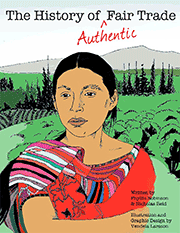The Via Campesina, the largest organization of small farmers in the world, has long advocated for changes in our agriculture and trade policies. For the past decade, they have been promoting the principles of Food Sovereignty as a way forward to protect rural communities, our food system, and the planet. As a movement that originated with small farmers in the South, there is much to learn from their concerns and their proposals. In a future blog article, I’ll talk more about the overlap between the Food Sovereignty and Fair Trade movements.
For now however, I’d like to just introduce you to some of the concepts being discussed in the Food Sovereignty movement…
A few months ago, I came across a very well-written and powerful article published by Food First, entitled, “Small farms as a planetary ecological asset: Five key reasons why we should support the revitalization of small farms in the Global South”, by Miguel A. Altieri, President of the Sociedad Cientifica LatinoAmericana de Agroecologia and Professor of Agroecology at the University of California, Berkeley. If you had any doubts about why small farmers are essential to our planet and our food system, and why we believe it is critical to support them, this article should answer any lingering questions.
I encourage you all to follow the link to his full article. Initially, I thought I might just try to summarize Altieri’s main points for those of you who might not have time to read the full article. To be perfectly honest, however, Altieri is so articulate and his points so well-made, I found it impossible to condense. So instead, and I hope he will forgive me, I’ve simply extracted many of his arguments verbatim.
Altieri identifies “…five reasons why it’s in the interest of Northern consumers to support the cause and struggle of small farmers in the South.” The following are excerpts taken directly from his article:
-
Small farmers are key for the world’s food security
While 91% of the planet’s 1.5 billion hectares of agricultural land are increasingly being devoted to agro-export crops, biofuels and transgenic soybean to feed cars and cattle, millions of small farmers in the Global South still produce the majority of staple crops needed to feed the planet’s rural and urban populations… Small increases in yields on these small farms that produce most of the world’s staple crops will have far more impact on food availability at the local and regional levels, than the doubtful increases predicted for distant and corporate-controlled large monocultures managed with such high tech solutions as genetically modified seeds.
-
Small farms are more productive and resource conserving than large-scale monocultures
Although the conventional wisdom is that small family farms are backward and unproductive, research shows that small farms are much more productive than large farms if total output is considered rather than yield from a single crop…. Not only do small to medium sized farms exhibit higher yields than conventional farms, but do so with much lower negative impact on the environment. Small farms are ‘multi-functional’ – more productive, more efficient, and contribute more to economic development than do large farms. Communities surrounded by many small farms have healthier economies than do communities surrounded by depopulated, large mechanized farms. Small farmers also take better care of natural resources, including reducing soil erosion and conserving biodiversity.
The inverse relationship between farm size and output can be attributed to the more efficient use of land, water, biodiversity and other agricultural resources by small farmers. So in terms of converting inputs into outputs, society would be better off with small-scale farmers. Building strong rural economies in the Global South based on productive small-scale farming will allow the people of the South to remain with their families and will help to stem the tide of migration. And as population continues to grow and the amount of farmland and water available to each person continues to shrink, a small farm structure may become central to feeding the planet, especially when large-scale agriculture devotes itself to feeding car tanks.
-
Small traditional and biodiverse farms are models of sustainability
Despite the onslaught of industrial farming, the persistence of thousands of hectares under traditional agricultural management documents a successful indigenous agricultural strategy of adaptability and resiliency. These microcosms of traditional agriculture that have stood the test of time, and that can still be found almost untouched since 4 thousand years in the Andes, MesoAmerica, Southeast Asia and parts of Africa, offer promising models of sustainability as they promote biodiversity, thrive without agrochemicals, and sustain year-round yields even under marginal environmental conditions. The local knowledge accumulated during millennia and the forms of agriculture and agrobiodiversity that this wisdom has nurtured, comprise a Neolithic legacy embedded with ecological and cultural resources of fundamental value for the future of humankind.
Recent research suggests that many small farmers cope and even prepare for climate change, minimizing crop failure through increased use of drought tolerant local varieties, water harvesting, mixed cropping, opportunistic weeding, agroforestry and a series of other traditional techniques. Surveys conducted in hillsides after Hurricane Mitch in Central America showed that farmers using sustainable practices such as “mucuna” cover crops, intercropping, and agroforestry suffered less “damage” than their conventional neighbors. The study spanning 360 communities and 24 departments in Nicaragua, Honduras and Guatemala showed that diversified plots had 20% to 40% more topsoil, greater soil moisture, less erosion, and experienced lower economic losses than their conventional neighbors.
This demonstrates that a re-evaluation of indigenous technology can serve as a key source of information on adaptive capacity and resilient capabilities exhibited by small farms – features of strategic importance for world farmers to cope with climatic change. In addition, indigenous technologies often reflect a worldview and an understanding of our relationship to the natural world that is more realistic and more sustainable than those of our Western European heritage.
-
Small farms represent a sanctuary of GMO-free agrobiodiversity
… In a worldwide survey of crop varietal diversity on farms involving 27 crops, scientists found that considerable crop genetic diversity continues to be maintained on farms in the form of traditional crop varieties, especially of major staple crops. In most cases, farmers maintain diversity as an insurance to meet future environmental change or social and economic needs. Many researchers have concluded that this varietal richness enhances productivity and reduces yield variability. For example, studies by plant pathologists provide evidence that mixing of crop species and or varieties can delay the onset of disease by reducing the spread of disease carrying spores, and by modifying environmental conditions so that they are less favorable to the spread of certain pathogens….
Maintaining pools of genetic diversity, geographically isolated from any possibility of cross fertilization or genetic pollution from uniform transgenic crops will create “islands” of intact germplasm which will act as extant safeguards against potential ecological failure derived from the second green revolution increasingly being imposed with programs such as the Gates-Rockefeller AGRA in Africa. These genetic sanctuary islands will serve as the only source of GMO-free seeds that will be needed to repopulate the organic farms in the North inevitably contaminated by the advance of transgenic agriculture. The small farmers and indigenous communities of the Global South, with the help of scientists and NGOs, can continue to create and guard biological and genetic diversity that has enriched the food culture of the whole planet.
-
Small farms cool the climate
While industrial agriculture contributes directly to climate change through no less than one third of total emissions of the major greenhouse gases – Carbon dioxide (CO2), methane (CH4), and nitrous oxide (N2O), small, biodiverse organic farms have the opposite effect by sequestering more carbon in soils. Small farmers usually treat their soils with organic compost materials that absorb and sequester carbon better than soils that are farmed with conventional fertilizers. Researchers have suggested that the conversion of 10,000 small- to medium-sized farms to organic production would store carbon in the soil equivalent to taking 1,174,400 cars off the road.
Further climate amelioration contributions by small farms accrue from the fact that most use significantly less fossil fuel in comparison to conventional agriculture mainly due to a reduction of chemical fertilizer and pesticide use, relying instead on organic manures, legume-based rotations, and diversity schemes to enhance beneficial insects…”
Altieri concludes: “Consumers of the North can play a major role by supporting these more equitable markets which do not perpetuate the colonial model of “agriculture of the poor for the rich,” but rather a model that promotes small biodiverse farms as the basis for strong rural economies in the Global South. Such economies will not only provide sustainable production of healthy, agroecologically-produced, accessible food for all, but will allow indigenous peoples and small farmers to continue their millennial work of building and conserving the agricultural and natural biodiversity on which we all depend now and even more so in the future.”
What better way to support the food sovereignty movement advocated for by the Via Campesina, than if the hundreds of thousands of consumers in the North were to choose to support small farmers, whether by reducing our own footprints, partnering with them to protect natural resources, or lobbying for more equitable agriculture and trade policies. A strong consumer movement in the North linked to the largest small farmer organization in the Global South could have a huge impact on our food system and our planet. There’s little time to lose.



Leave a comment